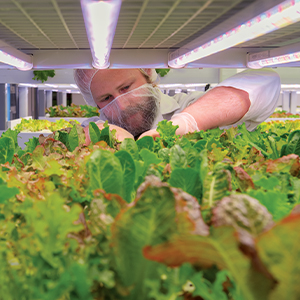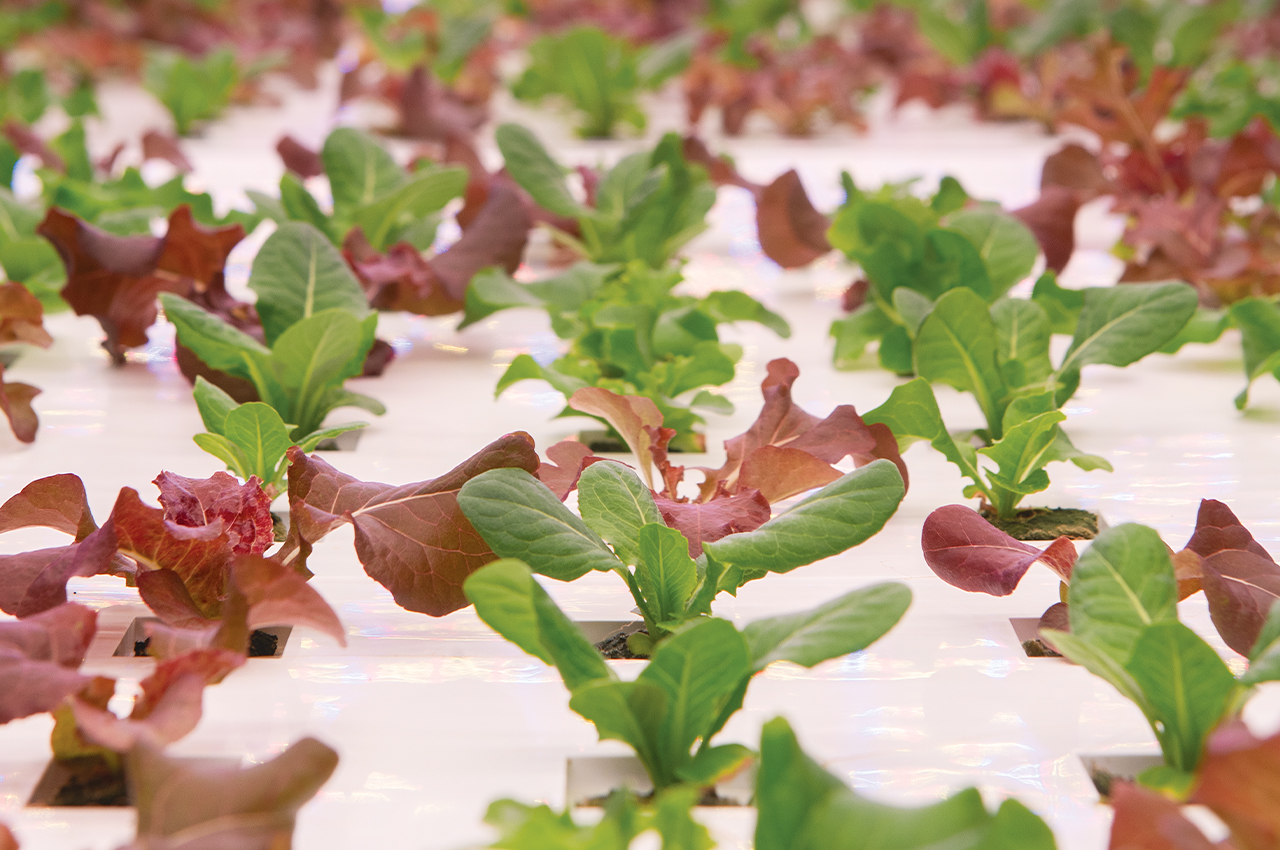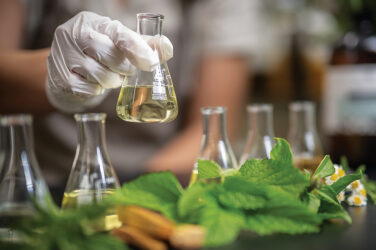Writer: Sarah Diehn
Photos: Duane Tinkey
Whether it’s on a local or global scale, finding, developing and implementing solutions for food insecurity requires innovative thinking.
WesleyLife built the Prairie Meadows Hydroponics Farm at its new Meals on Wheels campus in Des Moines to increase the nutritional quality of the 2,000 meals it delivers to older adults every day. The greens have been served in 20,000 meals in the last six months.
A hydroponic system provides plants with ideal conditions for fast growth, said Aaron Thormodsen, WesleyLife’s hydroponic farmer. “We have optimal temperature, optimal humidity, optimal nutrients, water levels, oxygen levels,” he said. “We make it so these plants can grow as fast as they physically can.”
With that speed, the plants can yield several harvests over their lifespan. The farm currently grows six varieties of leafy greens, which produce about 100 pounds of food per week, Thormodsen said.
The greens are distributed through Meals on Wheels deliveries and WesleyLife’s senior living communities, as well as Hugo’s Wood-Fired Kitchen, the restaurant Lynn Pritchard opened in May in the same building. Shannon Draayer, WesleyLife’s executive director of community nutrition, said her team plans to develop retail partnerships to help offset the farm’s costs.
As the hydroponic farm expands, Thormodsen hopes to harvest up to 150 pounds of greens each week by streamlining the processes for seeding, transplanting, cleaning and harvesting. He answered the following questions about hydroponics.
During a recent tour, Thormodsen explained how the operation works. His answers below have been lightly edited and condensed for clarity.
So what is hydroponics and how does it work?
Broadly speaking, hydroponics involves growing plants in water. The water provides all of the nutrients and the correct growing environment so the plants can pick up those nutrients. That means proper levels of dissolved oxygen and pH.
Generally speaking, hydroponic systems are recirculating. There’s a reservoir down below, which connects up to a pump that goes up to ball valves. The ball valves then drop water into these legs, which allows the water to flow down in a zigzag all the way down to a drain line that empties back to the reservoir.
We also pretreat the water. Des Moines water has minerals in it that are fine for a human, but in a hydroponic system where water gets concentrated, minerals like chlorine and sodium can become toxic to plants really quickly. We have a reverse-osmosis system where the water is prefiltered and then pumped into our reservoirs to refill them. We use a mixture of hydroponic nutrients, and there’s a part A and a part B, which allows us to balance the right amount of each nutrient.
Even with hydroponics, plants still have to root into something, so we use a soilless material called rockwool, which is a man-made stone wool. We’re also testing an organic peat moss sponge, and if that goes well, we’ll switch over to it so eventually we can compost the root systems.

Hydroponic farmer Aaron Thormodsen inspects a tray of plants being grown at the hydroponic farm on WesleyLife’s new Meals on Wheels campus in Des Moines.
How do the lights help the plants grow?
That’s its own Ph.D. study. Indoor grow lights are just a wild concept because we’ve essentially flattened the sun and brought it indoors. Broadly speaking, plants absorb all frequencies of light. Since most plants are green, they’re reflecting green and absorbing red and blue. But research shows that plants do like to pick up that green frequency. It’s more efficient, and they grow faster under that. Plants grow more roots in a blue spectrum, so if you’re growing young plants, you want to encourage root growth so the plants are heartier later in life. That’s why the germinating plants are under blue light. Older plants are under white and red light because the red spectrum induces faster growth. So it’s not that we’re just taking the sun and bringing it inside; we’re trying to make the sun more effective for specific types of plant growth.
How does hydroponic farming make food better or more plentiful?
Hydroponics is efficient in a couple different ways. The space usage is efficient in two ways: It’s vertical, but there’s also a higher density that you can’t really do in a traditional field. Plus, our product tastes better; that’s the truth of the matter. It’s not crunchy water. People want food that has flavor, and our product has a more tender texture and a better flavor. If you’re really trying to get folks to eat healthy, you have to provide a product people want to eat.
How else is hydroponics different?
In traditional agriculture, crops grow on the same soil year after year. Even with minor crop rotations, you’re still depleting the soil. So to keep growing salad greens in spaces like Salinas, California, and Yuma, Arizona, farmers grow varieties that can handle stress and pests, and they use automation. Handling and harvesting can be very difficult on greens, which can lose nutrients in the process. So farmers try to make sure their crops grow big and green and fast.
Hydroponics can’t work that way because we don’t have soil. We have to provide all the micronutrients the plants use, like 15 to 17 different nutrients. We know that only through hydroponics, because if something isn’t growing right, we can observe it and try to figure out what’s missing. By providing those additional nutrients, plants can grow those more complex phytonutrients that translate into healthier food.
What kind of plants can grow hydroponically?
Literally everything. The first farm I worked on was a research farm, where we grew everything from lettuce to fava beans to cauliflower to lemon trees. The reason why we’re growing mostly leafy greens is partly because they’re a nicer and easier product to start with. It’s consistent. There’s an easy market for it. The kitchen wants it and folks know how to use it.
Another reason we grow leafy greens is because it’s efficient. Energy converts directly into pounds of food. If you’re growing tomatoes, you may get 3 pounds off of a plant every week during the season, but the total biomass of that plant is 10 times that, and when you’re using indoor grow lights, that means your power usage is going to parts of the plant that you’ll never use. A lot of this is about efficiency.






